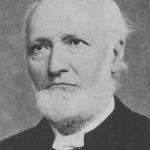
This is an installment of my series of replies to an article by Dr. David Madison: a pastor in the Methodist Church for nine years, who has a PhD in Biblical Studies from Boston University. It’s called, “Things We Wish Jesus Hadn’t Said” (Debunking Christianity, 7-21-19). His words will be in blue below. Dr. Madison makes several “generic” digs at Jesus and Christianity, in the written portion (it details a series of 12 podcasts):
A challenge for Christians: If you’re so sure Jesus existed, then you have some explaining to do. A major frustration is that, while believers are indignant at all the talk about Jesus not existing, they don’t know the issues that fuel the skepticism—and are unwilling to inform themselves.
Yes, I’m up to the “challenge.” No problem at all. I’m not threatened or “scared” by this in the slightest. It’s what I do, as an apologist. The question is whether Dr. Madison is up to interacting with counter-critiques? Or will he act like the voluminous anti-theist atheist polemicist Bob Seidensticker?: who directly challenged me in one of his own comboxes to respond to his innumerable attack-pieces against Christianity and the Bible, and then courageously proceeded to utterly ignore my 35 specific critiques of his claims as of this writing. We shall soon see which course Dr. Madison will decide to take. Anyway, he also states in his post and combox:
[S]o many of the words of Jesus are genuinely shocking. These words aren’t proclaimed much from the pulpit, . . . Hence the folks in the pews have absorbed and adored an idealized Jesus. Christian apologists make their livings refiguring so many of the things Jesus supposedly said.
The gospels are riddled with contradictions and bad theology, and Jesus is so frequently depicted as a cult fanatic—because cult fanatics wrote the gospels. We see Jesus only through their theological filters. I just want to grab hold of Christian heads (standing behind them, with a hand on each ear) and force them to look straight ahead, unflinchingly, at the gospels, and then ask “Tell me what you see!” uncoached by apologist specialists, i.e., priests and pastors, who’ve had a lot of practice making bad texts look good. . . . I DO say, “Deal with the really bad stuff in the gospels.” Are you SURE you’ve not make a big mistake endorsing this particular Lord and Savior? That’s the whole point of this series of Flash Podcasts, because a helluva lot of Christians would agree, right away, that these quotes are bad news—if no one told then that they’ve been attributed to Jesus.
Of course, Dr. Madison — good anti-theist atheist that he is — takes the view that we are not at all sure whether Jesus in fact said anything recorded in the Gospels in the first place. I don’t play that game, because there is no end to it. It’s like trying to pin jello to the wall. The atheist always has their convenient out (when refuted in argument about some biblical text) that Jesus never said it anyway [wink wink and sly patronizing grin], and/or that the biblical text in question was simply added later by dishonest ultra-biased Christian partisans and propagandists. It’s a silly and ultimately intellectually dishonest game, and so I always refuse to play it with atheists or anyone else, because there is no way to “win” with such an absurdly stacked, purely subjective deck.
In my defense of biblical texts, I start with the assumption that the manuscripts we have are quite sufficient for us to know what is in the Bible (believe it or not). Going on from there, I simply defend particular [supposedly “difficult”] texts, and note with appropriate argumentation, that “here, the Bible teaches so-and-so,” etc. I deal with the texts as they exist. I don’t get into the endlessly arbitrary, subjective games that atheists and theologically liberal biblical skeptics play with the texts, in their self-serving textual criticism.
Dr. Madison himself (fortunately) grants my outlook in terms of practical “x vs. y” debate purposes: “For the sake of argument, I’m willing to say, okay, Jesus was real and, yes, we have gospels that tell the story.” And in the combox: “So, we can go along with their insistence that he did exist. We’ll play on their field, i.e., the gospels.”
Good! So we shall examine his cherry-picked texts and see whether his interpretations of them can stand up to scrutiny. He is issuing challenges, and I as an apologist will be dishing a bunch of my own right back to him. Two can play this game. I will be dealing honestly with his challenges. Will he return the favor, and engage in serious and substantive dialogue? Again, we’ll soon know what his reaction will be. A true dialogue is of a confident, inquisitive, “nothing to fear and everything to gain” back-and-forth and interactive nature, not merely “ships passing in the night” or what I call “mutual monologue.”
*****
Dr. Madison’s 11th podcast of twelve is entitled: “On Matthew 10:34-39, Jesus came to bring a sword, and to set family members against one another”. Here is the passage:
Matthew 10:34-39 (RSV) “Do not think that I have come to bring peace on earth; I have not come to bring peace, but a sword. [35] For I have come to set a man against his father, and a daughter against her mother, and a daughter-in-law against her mother-in-law; [36] and a man’s foes will be those of his own household. [37] He who loves father or mother more than me is not worthy of me; and he who loves son or daughter more than me is not worthy of me; [38] and he who does not take his cross and follow me is not worthy of me. [39] He who finds his life will lose it, and he who loses his life for my sake will find it.
This quote is among those that really drags Jesus down and disqualifies him as a great moral teacher. . . . Why don’t Christians say, “Maybe we’ve made a mistake, worshiping this guy”? . . . People who love the colossal ego of Jesus as portrayed in John’s Gospel won’t be bothered by the arrogant Jesus on display here in Matthew 10. . . . Can we stop talking about Jesus as the Prince of Peace? And just think of the damage that this text has done in fueling Christian fanaticism. “We’re carrying the sword of Jesus,” said the Crusaders and the persecutors of the Inquisition. . . . C’mon! This is really despicable. There is no way to spin this to make Jesus look like a good guy. . . . Cults preach like this. . . . These words put Jesus firmly in the tradition of cult fanatics, who want undiluted devotion to themselves. . . . This is unhealthy religion, that damages people. It’s bad theology.
Matthew 10:37 provides the key to this whole passage, and in fact, helped to explain the issue dealt with in Podcast #1: Jesus supposedly telling His followers to hate their families. The point is that they are to love Him the most (the absence of which in the Bible is the sin of idolatry). And he informs them that there will be great costs involved in being His disciple (10:38), though these will result in ultimate fulfillment and reward (10:39). Jesus seems to virtually be citing Micah 7:6:
for the son treats the father with contempt, the daughter rises up against her mother, the daughter-in-law against her mother-in-law; a man’s enemies are the men of his own house.
He utilizes a literary device described below and His discourse is partly a prophecy that Christianity was in fact to cause a division in society and in the world ever since: i.e., many people didn’t like it then, just as they don’t today, which is why there is more persecution of Christians now, than at any time in history (according to even a secular magazine like Newsweek).
Sometimes, families are split, and there have been even civil wars over religious matters. Try to be openly, publicly Christian in, for example, Saudi Arabia or Iran today, and see how well things go for you. Why is it that churches are being attacked in alarmingly great numbers all over Europe? According to one article:
Countries like France and Germany have seen a spike in violent vandalism, desecrating cherished churches and Christian symbols in recent months and years.
According to the German news site PI-News, every day in France, two churches are desecrated. They report 1,063 attacks on Christian churches or symbols like crucifixes, icons, and statues in France in 2018, marking a 17 percent increase from the year before.
It’s because there has been opposition to Christianity from the start. Christianity severely critiques the world-system, and the world doesn’t like it one bit. It’s not rocket science, then, to understand what Jesus was expressing here. It’s only the literary genre that is confusing folks like Dr. Madison. What He was driving at is made perfectly clear in the larger context (which Dr. Madison — like virtually all atheist “exegetes” habitually do — completely ignores):
Matthew 24:16-18, 21-25, 28 “Behold, I send you out as sheep in the midst of wolves; so be wise as serpents and innocent as doves. [17] Beware of men; for they will deliver you up to councils, and flog you in their synagogues, [18] and you will be dragged before governors and kings for my sake, to bear testimony before them and the Gentiles. . . . [21] Brother will deliver up brother to death, and the father his child, and children will rise against parents and have them put to death; [22] and you will be hated by all for my name’s sake. But he who endures to the end will be saved. [23] When they persecute you in one town, flee to the next; for truly, I say to you, you will not have gone through all the towns of Israel, before the Son of man comes. [24] “A disciple is not above his teacher, nor a servant above his master; [25] it is enough for the disciple to be like his teacher, and the servant like his master. If they have called the master of the house Be-el’zebul, how much more will they malign those of his household. . . . [28] And do not fear those who kill the body but cannot kill the soul; rather fear him who can destroy both soul and body in hell.”
This is the backdrop, and this explains Jesus’ meaning:
1) The world has hated Me, and so they will hate you also, as My followers.
2) This hatred will extend even to families, where non-Christian families may persecute Christians in the family.
3) If your family hates you, you have to choose between it and your ultimate allegiance to God [and I am God].
Jesus doesn’t desire or will or endorse or sanction any of this, which is Dr. Madison’s central and utterly erroneous point (as is quite obvious, I think, in 24:16-28 above). He is simply stating it in a typically pungent Hebraic / Semitic style. And he is using a literary technique, which has a name: Metonymy (or, Change of Name / Noun).
In my Installment #1, I mentioned Bible scholar E. W. Bullinger, who described and explained “over 200 distinct figures [in the Bible], several of them with from 30 to 40 varieties.” His 1104-page tome is called, Figures of Speech Used in the Bible (London: 1898). It’s available for free, online. Bullinger devotes no less than 75 pages to Metonymy (pp. 538-612) [see the entire section in a nice format online]. He defines it as follows:
The Change of one Noun for another Related Noun.
. . . Metonymy is a figure by which one name or noun is used instead of another, to which it stands in a certain relation.
The change is in the noun, and only in a verb as connected with the action proceeding from it. . . .
Thus it will be seen that Metonymy is not founded on resemblance, but on relation.
When we say that a person writes ” a bad hand,” we do not mean a hand, but we use the noun ” hand ” for the characters which it writes.
Metonymy is of four kinds: viz., of the Cause, of the Effect, of the Subject, and of the Adjunct.
I. Metonymy of the Cause is when the cause is put for the effect: i.e., when the doer is put for the thing done; or, the instrument for that which is effected; or, where the action is put for the effect produced by the action. (p. 538)
Metonymy of the Cause is the kind that occurs in our disputed passage, which Bullinger cites under his examples (p. 548). He comments on Matthew 10:34: “That is to say, the object of His coming was peace, but the effect of it was war.” In other words, Jesus’ technique (rather common in prophetic-type utterance in the Old Testament) was to speak poetically, as if He directly caused or willed what He only directly “caused” by being the object of the displeasure and disagreement of those who would reject Him and His followers. So He says:
I have not come to bring peace, but a sword. For I have come to set a man against his father, and a daughter against her mother . . . He who loves father or mother more than me is not worthy of me.
This is poetic expression, utilizing Metonymy of the Cause, where “the cause is put for the effect”. But His literal meaning may be paraphrased as follows:
I came to bring peace, but the effect is, rather [in some cases], a sword [serious conflict]. The [undesired] result of my coming [in extreme cases] will be a man against his father, and a daughter against her mother . . . [If it tragically gets to this point] He who loves father or mother more than me is not worthy of me [which love would be idolatry].
I’ve seen war movies, where a commander of so many soldiers said to another commander, “I killed 14 of my men.” OI remember being jolted by that when I first heard it. Then, after a moment’s reflection, I “got” it. This is the same sort of non-literal language. Of course, literally, his soldiers were killed by the enemy; they were the cause, not the commander, who did not desire this outcome. But he put it that way because he was trying to express, in his understandable human feeling and compassion: “if I had not sent these men into battle, onto the front lines, they would still be alive [i.e., I ‘killed’ them].”
That is true, but it’s not direct cause. Likewise, Jesus is talking in this same way, saying in effect: “If I had not come and taught what I teach, then we wouldn’t have families being divided as a result.” In that sense only, He caused it, but not directly. Hence, “I bring a sword.” The division is directly caused by those who choose to engage in it, and to persecute folks for following Jesus.
Robert H. Stein wrote a very helpful article entitled, “Jesus’ Use of Figurative Language.” He states:
Jesus evidently prepared his teaching, putting it into literary forms using the metaphorical, exaggerating, impressionistic language of a culture that loved to tell stories. This helped his listeners remember easily what he taught. . . . Jesus thought his hearers were capable of understanding figurative language and he expected them to do so, . . .
He goes on to list (with many examples) many of the literary forms Jesus used: simile, metaphor, poetry, proverb, hyperbole, puns, paradox, a fortiori, use of [Socratic] questioning (I have written about that, myself), irony, synecdoche, personification, paranomasia, and anthropomorphism (that I have also described at length).
Pulpit Commentary, for Matthew 10:35, sagely states: “Christ would leave in his hearers’ minds no room for thinking that he was ignorant of what the immediate result of his coming would be.”
***
Photo credit: The Christian Martyrs’ Last Prayer, by Jean-Léon Gérôme (1824-1904) [public domain / Wikimedia Commons]
***













